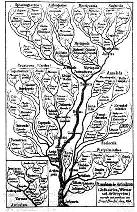 It has been customary since the nineteenth century to depict the progress of evolution as a tree. A typical one, at right, was drawn by Ernst Haeckel, in 1866, to represent the phylogeny of arthropods. Each species is represented by a separate branch, so the diversity of species is evident from the number of branches. The height of the tree has come to represent the level of biological organization, so higher branches would represent "higher" forms of life. Hence, a tree that depicted all species would have very many low branches representing the wide variety of bacterial species, and fewer branches at the top, where primates and ultimately mankind emerge. Higher branches also represent later developments, as for real trees. Thus the tree implies that biological evolution tends over time to progress to "higher" forms of life.
It has been customary since the nineteenth century to depict the progress of evolution as a tree. A typical one, at right, was drawn by Ernst Haeckel, in 1866, to represent the phylogeny of arthropods. Each species is represented by a separate branch, so the diversity of species is evident from the number of branches. The height of the tree has come to represent the level of biological organization, so higher branches would represent "higher" forms of life. Hence, a tree that depicted all species would have very many low branches representing the wide variety of bacterial species, and fewer branches at the top, where primates and ultimately mankind emerge. Higher branches also represent later developments, as for real trees. Thus the tree implies that biological evolution tends over time to progress to "higher" forms of life.
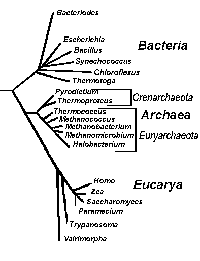 Harvard biologist and writer Stephen Jay Gould believes there is no prescribed hierarchy of life; evolution wanders aimlessly, and is as likely to go down as up. Therefore, he has said that the tree of life is a low bush.
Harvard biologist and writer Stephen Jay Gould believes there is no prescribed hierarchy of life; evolution wanders aimlessly, and is as likely to go down as up. Therefore, he has said that the tree of life is a low bush.
The art of drawing such trees has become more scientific, it is claimed, because now the actual sequences of genes can be compared. It is logical to hold that the more similar genes are, the more closely related are the organisms that carry them. Thus the gene for the RNA in the smaller unit of the ribosome, a gene all cells carry, has been sequenced for many species and used to draw a mathematical tree of life like the one at left.
Work like this has been under way since at least 1977 (1). Carl Woese of the University of Illinios at Urbana Champaign is a pioneer of the new method. He first proposed that archaebacteria are different enough to warrant the recognition of a new third domain called archaea. This proposal became widely accepted by about 1996; it is corroborated by several lines of evidence, not just the sequence of one gene (2).
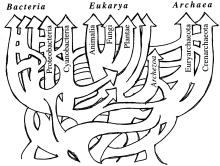 But, promising as the new method is, it turns out to be flawed from the Darwinian perspective. The problem is that when different genes are used to draw the tree, different trees result. This problem is explained if evolution makes extensive use of genes that are transfered horizontally, as in Cosmic Ancestry, instead of only vertically, as in Darwinism. Horizontal gene transfer produces complex trees with criss-crossing branches (3), instead of simple, fan-shaped trees. But, promising as the new method is, it turns out to be flawed from the Darwinian perspective. The problem is that when different genes are used to draw the tree, different trees result. This problem is explained if evolution makes extensive use of genes that are transfered horizontally, as in Cosmic Ancestry, instead of only vertically, as in Darwinism. Horizontal gene transfer produces complex trees with criss-crossing branches (3), instead of simple, fan-shaped trees.
 Furthermore, Cosmic Ancestry holds that without the benefit of new genetic programs acquired by horizontal transfer, evolution would go only sideways or downhill, and the tree of life would be a hanging plant. In order for life to ascend the tree — for genuine improvements to evolve — new genetic programs must be supplied. These new programs could be resident already within life somewhere, as silent DNA. Perhaps the expression of these programs was impossible until other biological or environmental developments were complete. Or, the genetic programs could possibly be new arrivals, delivered in the same manner as life on Earth originally was. They could be carried here by bacterial spores, or they could possibly arrive in viruses. Both spores and viruses could be delivered by meteorites directly to the Earth's surface, or descend through the atmosphere as dust shed by comets. After arrival, the new genetic programs could be installed and transferred by viruses or other methods now becoming understood. According to cosmic ancestry, evolution can only climb the tree of life when genetic programs, newly acquired or long-held, are expressed for the first time. Furthermore, Cosmic Ancestry holds that without the benefit of new genetic programs acquired by horizontal transfer, evolution would go only sideways or downhill, and the tree of life would be a hanging plant. In order for life to ascend the tree — for genuine improvements to evolve — new genetic programs must be supplied. These new programs could be resident already within life somewhere, as silent DNA. Perhaps the expression of these programs was impossible until other biological or environmental developments were complete. Or, the genetic programs could possibly be new arrivals, delivered in the same manner as life on Earth originally was. They could be carried here by bacterial spores, or they could possibly arrive in viruses. Both spores and viruses could be delivered by meteorites directly to the Earth's surface, or descend through the atmosphere as dust shed by comets. After arrival, the new genetic programs could be installed and transferred by viruses or other methods now becoming understood. According to cosmic ancestry, evolution can only climb the tree of life when genetic programs, newly acquired or long-held, are expressed for the first time.
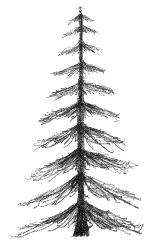
This evolutionary process would give the the tree of life aspects of a spruce with tiers of branches. Darwinian evolution can enable life to explore a given level of the canopy, because the needed genetic programs have been supplied. But in order for life to climb the tree to a higher level, new genetic programs are required — which mutation and recombination alone cannot supply. When they are supplied, a major advance may ensue. Thus, by cosmic ancestry, the problem of punctuated equilibrium is also resolved.
A consequence of this reasoning is that life on Earth can have descended only from life elsewhere with evolutionary potential at least equal to our own.

 "Trees as a metaphor to understand relationships in biology" by Roland G. Roberts, PLoS Biol, 28 May 2024 (Illustration by Ernst Haeckel, 1879, left).
We need to ensure that the metaphor serves us without constraining us, but on the whole, it largely holds water. "Trees as a metaphor to understand relationships in biology" by Roland G. Roberts, PLoS Biol, 28 May 2024 (Illustration by Ernst Haeckel, 1879, left).
We need to ensure that the metaphor serves us without constraining us, but on the whole, it largely holds water.
 "Phylogenomics and the rise of the angiosperms" by A.R. Zuntini, T. Carruthers, O. Maurin et al., Nature, 24 Apr 2024.
Gene tree conflict is tightly linked to diversification across the tree. "Phylogenomics and the rise of the angiosperms" by A.R. Zuntini, T. Carruthers, O. Maurin et al., Nature, 24 Apr 2024.
Gene tree conflict is tightly linked to diversification across the tree.
 "Phylogenetic congruence, conflict and consilience between molecular and morphological data" by J.N. Keating, R.J. Garwood and R.S. Sansom, BMC Ecol Evo, 05 Jul 2023.
Our results reveal that morphological-molecular topological incongruence is pervasive: these data partitions yield very different trees, irrespective of which method is used for morphology inference. Analysis of the combined data often yields unique trees that are not sampled by either partition individually.... "Phylogenetic congruence, conflict and consilience between molecular and morphological data" by J.N. Keating, R.J. Garwood and R.S. Sansom, BMC Ecol Evo, 05 Jul 2023.
Our results reveal that morphological-molecular topological incongruence is pervasive: these data partitions yield very different trees, irrespective of which method is used for morphology inference. Analysis of the combined data often yields unique trees that are not sampled by either partition individually....
 "Incongruence in the phylogenomics era" by J.L. Steenwyk, Y. Li, X. Zhou et al.,
Nat Rev Genet, 27 Jun 2023. "Incongruence in the phylogenomics era" by J.L. Steenwyk, Y. Li, X. Zhou et al.,
Nat Rev Genet, 27 Jun 2023.
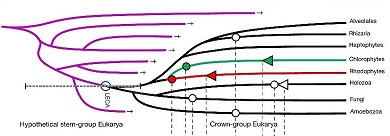
 22 Jun 2023: ...a wholly separate eukaryotic phylogeny prior to the Last Eukaryotic Common Ancestor. (See image, right.) 22 Jun 2023: ...a wholly separate eukaryotic phylogeny prior to the Last Eukaryotic Common Ancestor. (See image, right.)
 "Microbial predators form a new supergroup of eukaryotes," by Denis V. Tikhonenkov et al., doi:10.1038/s41586-022-05511-5, Nature, 07 Dec 2022. "Microbial predators form a new supergroup of eukaryotes," by Denis V. Tikhonenkov et al., doi:10.1038/s41586-022-05511-5, Nature, 07 Dec 2022.
 Evolving Perspective on the Origin and Diversification of Cellular Life and the Virosphere by Anja Spang et al., doi:10.1093/gbe/evac034, Genome Biology and Evolution, Jun (online 26 Feb) 2022. The TOL is a constantly changing and evolving concept in evolutionary biology.... Evolving Perspective on the Origin and Diversification of Cellular Life and the Virosphere by Anja Spang et al., doi:10.1093/gbe/evac034, Genome Biology and Evolution, Jun (online 26 Feb) 2022. The TOL is a constantly changing and evolving concept in evolutionary biology....
 Welcome to the OneZoom tree of life explorer..., 14 Dec 2021; and background: Welcome to the OneZoom tree of life explorer..., 14 Dec 2021; and background:
 Dynamic visualisation of million-tip trees: The OneZoom project by Yan Wong and James Rosindell, Methods in Ecology and Evolution, 13 Dec 2021. Dynamic visualisation of million-tip trees: The OneZoom project by Yan Wong and James Rosindell, Methods in Ecology and Evolution, 13 Dec 2021.
 How a Butterfly Tree Becomes a Web by Casey McGrath, Genome Biology and Evolution, 22 Jul 2021. How a Butterfly Tree Becomes a Web by Casey McGrath, Genome Biology and Evolution, 22 Jul 2021.
 The past, present and future of the tree of life by Cédric Blais and John M. Archibald, Current Biology, 02 Apr 2021. The past, present and future of the tree of life by Cédric Blais and John M. Archibald, Current Biology, 02 Apr 2021.
 Illuminating the first bacteria by Laura A. Katz, Science, 07 May 2021. ... there is room for alternative methods and innovation to encompass both vertical and lateral inheritance.... Illuminating the first bacteria by Laura A. Katz, Science, 07 May 2021. ... there is room for alternative methods and innovation to encompass both vertical and lateral inheritance....
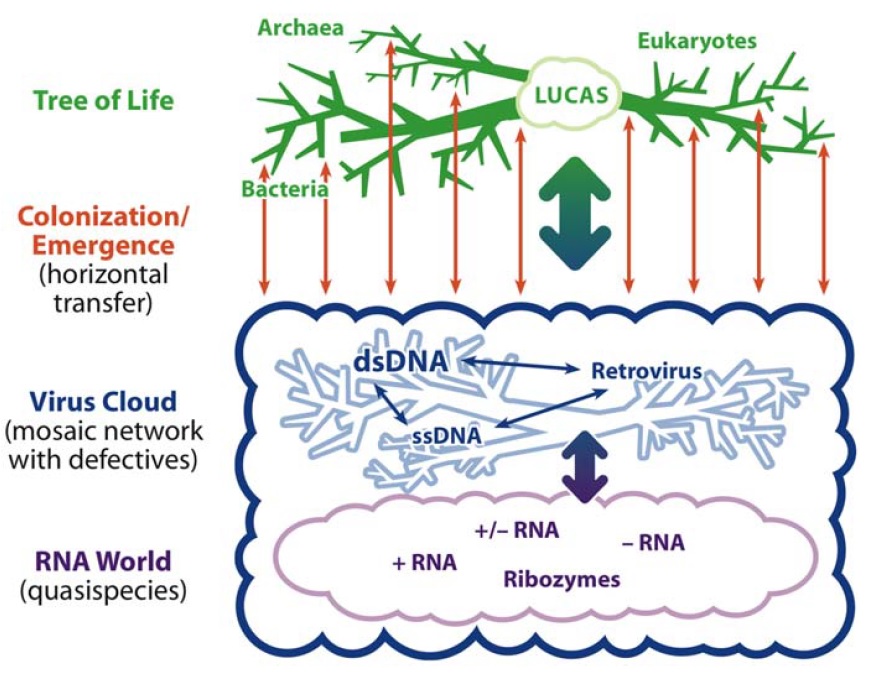
 Viruses are essential agents within the roots and stem of the tree of life by Luis P. Villarreal and Guenther Witzany, Journal of Theoretical Biology, doi:10.1016/j.jtbi.2009.10.014, 21 Feb 2010. See illustration at left. Viruses are essential agents within the roots and stem of the tree of life by Luis P. Villarreal and Guenther Witzany, Journal of Theoretical Biology, doi:10.1016/j.jtbi.2009.10.014, 21 Feb 2010. See illustration at left.
 16 May 2019: The overall picture is still unclear. 16 May 2019: The overall picture is still unclear.
 Geological and Geochemical Constraints on the Origin and Evolution of Life by Norman H. Sleep, Astrobiology, online 12 Sep 2018. The traditional tree of life from molecular biology ...is likely formally valid enough to be a basis for discussion of geological processes on the early Earth. Geological and Geochemical Constraints on the Origin and Evolution of Life by Norman H. Sleep, Astrobiology, online 12 Sep 2018. The traditional tree of life from molecular biology ...is likely formally valid enough to be a basis for discussion of geological processes on the early Earth.
 Phylogenomic evidence for ancient recombination between plastid genomes... by Andan Zhu, Weishu Fan et al., BMC Evolutionary Biology, 10 Sep 2018. These results demonstrate that standard phylogenomic analyses can result in strongly supported but conflicting trees. Phylogenomic evidence for ancient recombination between plastid genomes... by Andan Zhu, Weishu Fan et al., BMC Evolutionary Biology, 10 Sep 2018. These results demonstrate that standard phylogenomic analyses can result in strongly supported but conflicting trees.
 Interspecies Hybrids Play a Vital Role in Evolution by Jordana Cepelewicz, Quanta, 24 Aug 2018. Interspecies Hybrids Play a Vital Role in Evolution by Jordana Cepelewicz, Quanta, 24 Aug 2018.
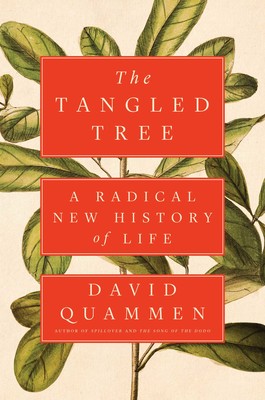  06 Sep 2018: The Tangled Tree, by science writer David Quammen. 06 Sep 2018: The Tangled Tree, by science writer David Quammen.
 ...Archaic DNA Rewrites Human Evolution, University of Utah (+Newswise), 02 Aug 2017. ...Archaic DNA Rewrites Human Evolution, University of Utah (+Newswise), 02 Aug 2017.
 Reshaping Darwin's Tree of Life, Newswise, 07 Jun 2017. Reshaping Darwin's Tree of Life, Newswise, 07 Jun 2017.
 26 Feb 2017: ...the common ancestor ...did encode many of the protein domains of all three super-kingdoms. 26 Feb 2017: ...the common ancestor ...did encode many of the protein domains of all three super-kingdoms.
 Shaking up the Tree of Life by Elizabeth Pennisi, doi:10.1126/science.354.6314.817, Science, 18 Nov 2016. Shaking up the Tree of Life by Elizabeth Pennisi, doi:10.1126/science.354.6314.817, Science, 18 Nov 2016.
 Sequencing of the genus Arabidopsis identifies a complex history of nonbifurcating speciation and abundant trans-specific polymorphism by Polina Yu Novikova et al., doi:10.1038/ng.3617, v 48 Nature Genetics, Sep (online 18 Jul) 2016. We uncovered multiple cases of past gene flow that contradict a bifurcating species tree. Sequencing of the genus Arabidopsis identifies a complex history of nonbifurcating speciation and abundant trans-specific polymorphism by Polina Yu Novikova et al., doi:10.1038/ng.3617, v 48 Nature Genetics, Sep (online 18 Jul) 2016. We uncovered multiple cases of past gene flow that contradict a bifurcating species tree.
 15 Apr 2016: Microbiology ...threatening to "uproot the Tree of Life", re: 15 Apr 2016: Microbiology ...threatening to "uproot the Tree of Life", re:
 What Is the Tree of Life?, doi:10.1371/journal.pgen.1005912, PLoS Genet, 14 Apr 2016. What Is the Tree of Life?, doi:10.1371/journal.pgen.1005912, PLoS Genet, 14 Apr 2016.
 Inferring Phylogenetic Networks with Maximum Pseudolikelihood under Incomplete Lineage Sorting, Claudia Solís-Lemus and Cécile Ané, doi:10.1371/journal.pgen.1005896, PLoS Genet, 07 Mar 2016. Inferring Phylogenetic Networks with Maximum Pseudolikelihood under Incomplete Lineage Sorting, Claudia Solís-Lemus and Cécile Ané, doi:10.1371/journal.pgen.1005896, PLoS Genet, 07 Mar 2016.
 Assessing parallel gene histories in viral genomes, Mengual-Chuliá et al., doi:10.1186/s12862-016-0605-4, BMC Evolutionary Biology, 05 Feb 2016. Assessing parallel gene histories in viral genomes, Mengual-Chuliá et al., doi:10.1186/s12862-016-0605-4, BMC Evolutionary Biology, 05 Feb 2016.
 Synthesis of phylogeny and taxonomy into a comprehensive tree of life by Cody E. Hinchliff et al., doi:10.1073/pnas.1423041112, PNAS, 13 Oct 2015. Synthesis of phylogeny and taxonomy into a comprehensive tree of life by Cody E. Hinchliff et al., doi:10.1073/pnas.1423041112, PNAS, 13 Oct 2015.
 9 Oct 2015: [T]he signature advanced functional systems of the eukaryotic cells were already present in the last eukaryotic common ancestor.... 9 Oct 2015: [T]he signature advanced functional systems of the eukaryotic cells were already present in the last eukaryotic common ancestor....
 Kasie Raymann et al., "The two-domain tree of life is linked to a new root for the Archaea" [abstract], doi:10.1073/pnas.1420858112, PNAS, 11 May 2015. Kasie Raymann et al., "The two-domain tree of life is linked to a new root for the Archaea" [abstract], doi:10.1073/pnas.1420858112, PNAS, 11 May 2015.
 7 May 2015: An Interview with Ford Doolittle, PLoS Genet. 7 May 2015: An Interview with Ford Doolittle, PLoS Genet.
 Roland G. Roberts, "The Blind Men and the Piwi Elephant—Opening a Can of Worms" [html], doi:10.1371/journal.pbio.1002062, 13(2): e1002062, PLoS Biol, 10 Feb 2015. Roland G. Roberts, "The Blind Men and the Piwi Elephant—Opening a Can of Worms" [html], doi:10.1371/journal.pbio.1002062, 13(2): e1002062, PLoS Biol, 10 Feb 2015.
 Marc Hellmuth et al., "Phylogenomics with paralogs" [abstract], doi:10.1073/pnas.1412770112, Proc. Natl. Acad. Sci. USA, online 2 Feb 2015. Marc Hellmuth et al., "Phylogenomics with paralogs" [abstract], doi:10.1073/pnas.1412770112, Proc. Natl. Acad. Sci. USA, online 2 Feb 2015.
 15 Jan 2015: Bacterial gene swapping, called horizontal gene transfer by microbiologists, is like a messy game of telephone. 15 Jan 2015: Bacterial gene swapping, called horizontal gene transfer by microbiologists, is like a messy game of telephone.
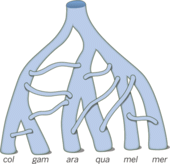
 Andrew G. Clark and Philipp W. Messer, "Conundrum of jumbled mosquito genomes" [abstract], doi:10.1126/science.aaa3600, p 27-28 v 347, Science, 2 Jan 2015. Andrew G. Clark and Philipp W. Messer, "Conundrum of jumbled mosquito genomes" [abstract], doi:10.1126/science.aaa3600, p 27-28 v 347, Science, 2 Jan 2015.
 Thorsten Thiergart, Giddy Landan and William F Martin, "Concatenated alignments and the case of the disappearing tree" [abstract], doi:10.1186/s12862-014-0266-0, n2624 v14, BMC Evolutionary Biology, 30 Dec 2014. Thorsten Thiergart, Giddy Landan and William F Martin, "Concatenated alignments and the case of the disappearing tree" [abstract], doi:10.1186/s12862-014-0266-0, n2624 v14, BMC Evolutionary Biology, 30 Dec 2014.
 25 Oct 2014: Horizontal gene transfer is ...not limited to microbes. 25 Oct 2014: Horizontal gene transfer is ...not limited to microbes.
 Fabien Burki, "The Eukaryotic Tree of Life from a Global Phylogenomic Perspective" [abstract], doi:10.1101/cshperspect.a016147, p 181-197, The Origin And Evolution Of Eukaryotes, Patrick J. Keeling and Eugene V. Konin, eds., ISBN-10:1621820289, Cold Spring Harbor Laboratory Press, 31 May 2014. Fabien Burki, "The Eukaryotic Tree of Life from a Global Phylogenomic Perspective" [abstract], doi:10.1101/cshperspect.a016147, p 181-197, The Origin And Evolution Of Eukaryotes, Patrick J. Keeling and Eugene V. Konin, eds., ISBN-10:1621820289, Cold Spring Harbor Laboratory Press, 31 May 2014.
 31 Oct 2013: Evolution is mediated ...also through the mixture of genomic material between individuals of different lineages. 31 Oct 2013: Evolution is mediated ...also through the mixture of genomic material between individuals of different lineages.
 28 May 2013: All gene trees differ from species phylogeny — Salichos and Rokas 28 May 2013: All gene trees differ from species phylogeny — Salichos and Rokas
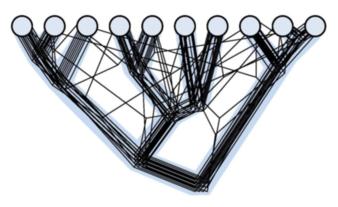
 Pere Puigbò, Yuri I Wolf and Eugene V Koonin, "Seeing the Tree of Life behind the phylogenetic forest" [html], doi:10.1186/1741-7007-11-46, n46 v11, BMC Biology, 15 Apr 2013 (see illustration at right.) Pere Puigbò, Yuri I Wolf and Eugene V Koonin, "Seeing the Tree of Life behind the phylogenetic forest" [html], doi:10.1186/1741-7007-11-46, n46 v11, BMC Biology, 15 Apr 2013 (see illustration at right.)
 Digging Down Below the Tree of Life by Michael Schirber, Astrobiology Magazine, 28 Mar 2013. Digging Down Below the Tree of Life by Michael Schirber, Astrobiology Magazine, 28 Mar 2013.
 Nigel Goldenfeld and Norman R. Pace, "Carl R. Woese (1928-2012)" [first paragraph], doi:10.1126/science.1235219, p661 v339, Science, 8 Feb 2013. Nigel Goldenfeld and Norman R. Pace, "Carl R. Woese (1928-2012)" [first paragraph], doi:10.1126/science.1235219, p661 v339, Science, 8 Feb 2013.
 Harry Noller, "Carl R. Woese (1928-2012)" [html], doi:10.1038/493610a, p610 v493, Nature, 31 Jan 2013. Harry Noller, "Carl R. Woese (1928-2012)" [html], doi:10.1038/493610a, p610 v493, Nature, 31 Jan 2013.
 Elizabeth Pennisi, "New Way to Look at Life" [summary], doi:10.1126/science.338.6105.317, p317 v338, Science, 19 Oct 2012. Elizabeth Pennisi, "New Way to Look at Life" [summary], doi:10.1126/science.338.6105.317, p317 v338, Science, 19 Oct 2012.
 13 Sept 2012: ...the horizontal flow of genes is a part of the story of life. 13 Sept 2012: ...the horizontal flow of genes is a part of the story of life.
 Elie Golgin, "Rewriting Evolution" [html], doi:10.1038/486460a, p460-462 v486, Nature, 28 Jun 2012. "Tiny molecules called microRNAs are tearing apart traditional ideas about the animal family tree." Elie Golgin, "Rewriting Evolution" [html], doi:10.1038/486460a, p460-462 v486, Nature, 28 Jun 2012. "Tiny molecules called microRNAs are tearing apart traditional ideas about the animal family tree."
 Sophie S. Abby et al., "Lateral gene transfer as a support for the tree of life" [abstract], doi:10.1073/pnas.1116871109, p4962-4967 v109, Proc. Natl. Acad. Sci. USA, 27 Mar 2012. Sophie S. Abby et al., "Lateral gene transfer as a support for the tree of life" [abstract], doi:10.1073/pnas.1116871109, p4962-4967 v109, Proc. Natl. Acad. Sci. USA, 27 Mar 2012.
 Hervé Philippe and Béatrice Roure, "Difficult phylogenetic questions: more data, maybe; better methods, certainly" [abstract], doi:10.1186/1741-7007-9-91, v9 n91, BMC Biology, 29 Dec 2011. Hervé Philippe and Béatrice Roure, "Difficult phylogenetic questions: more data, maybe; better methods, certainly" [abstract], doi:10.1186/1741-7007-9-91, v9 n91, BMC Biology, 29 Dec 2011.
 Beyond the Tree of Life: a new thematic series from BioMedCentral, 12 Jul 2011. Beyond the Tree of Life: a new thematic series from BioMedCentral, 12 Jul 2011.
 17 Apr 2011: How important is lateral gene transfer? (Jerry Coyne's blog) 17 Apr 2011: How important is lateral gene transfer? (Jerry Coyne's blog)
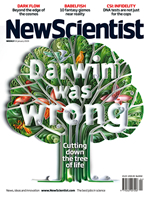
 Graham Lawton, "Why Darwin was wrong about the tree of life" [preview], NewScientist, 21 Jan 2009. Graham Lawton, "Why Darwin was wrong about the tree of life" [preview], NewScientist, 21 Jan 2009.
 Discovery of jumping gene cluster tangles tree of life by David Salisbury, Vanderbilt University, 4 Feb 2011. Discovery of jumping gene cluster tangles tree of life by David Salisbury, Vanderbilt University, 4 Feb 2011.
 Jessica E Light et al., "Evolutionary history of mammalian sucking lice (Phthiraptera: Anoplura)" [abstract], doi:10.1186/1471-2148-10-292, v10 n292, BMC Evolutionary Biology, 22 Sep 2010. "We find significant conflict between phylogenies constructed using molecular and morphological data." Jessica E Light et al., "Evolutionary history of mammalian sucking lice (Phthiraptera: Anoplura)" [abstract], doi:10.1186/1471-2148-10-292, v10 n292, BMC Evolutionary Biology, 22 Sep 2010. "We find significant conflict between phylogenies constructed using molecular and morphological data."
 Ruben E Valas and Philip E Bourne, "Save the tree of life or get lost in the woods" [abstract], doi:10.1186/1745-6150-5-44, v5 paper 44, Biology Direct, 1 Jul 2010. Ruben E Valas and Philip E Bourne, "Save the tree of life or get lost in the woods" [abstract], doi:10.1186/1745-6150-5-44, v5 paper 44, Biology Direct, 1 Jul 2010.
 Douglas L. Theobald, "A formal test of the theory of universal common ancestry" [abstract | Editor's Summary], doi:10.1038/nature09014, p219–222 v465, Nature, 13 May 2010. Also see commentary — Douglas L. Theobald, "A formal test of the theory of universal common ancestry" [abstract | Editor's Summary], doi:10.1038/nature09014, p219–222 v465, Nature, 13 May 2010. Also see commentary —
 Mike Steel and David Penny, "Origins of life: Common ancestry put to the test" [html], doi:10.1038/465168a, p168-169 v465, Nature, 13 May 2010. And — Mike Steel and David Penny, "Origins of life: Common ancestry put to the test" [html], doi:10.1038/465168a, p168-169 v465, Nature, 13 May 2010. And —
 Katherine Harmon, "The Proof Is in the Proteins: Test Supports Universal Common Ancestor for All Life" [html], Scientific American, 13 May 2010. Katherine Harmon, "The Proof Is in the Proteins: Test Supports Universal Common Ancestor for All Life" [html], Scientific American, 13 May 2010.
 W. P. Hanage, "The Trouble with Trees" (review of The New Foundations of Evolution: On the Tree of Life by Jan Sapp), [summary], doi:10.1126/science.1185784, p 645-646 v 327, Science, 5 Feb 2010. W. P. Hanage, "The Trouble with Trees" (review of The New Foundations of Evolution: On the Tree of Life by Jan Sapp), [summary], doi:10.1126/science.1185784, p 645-646 v 327, Science, 5 Feb 2010.
 11 Dec 2009: ...the percentage of genes transferred ...could be close to 100% — Cordero and Hogeweg. 11 Dec 2009: ...the percentage of genes transferred ...could be close to 100% — Cordero and Hogeweg.
 21 Aug 2009: I find it fascinating that this prokaryotic symbiosis could so profoundly shape the evolution of life.... 21 Aug 2009: I find it fascinating that this prokaryotic symbiosis could so profoundly shape the evolution of life....
 20 Jun 2009: The tree of life was always a net. Nature was always a genetic engineer. 20 Jun 2009: The tree of life was always a net. Nature was always a genetic engineer.
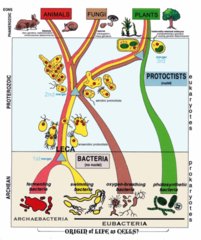
 16 Mar 2009: ...gene transfers of various types... and other forms of acquisition of 'foreign genomes' ...are more important....— Lynn Margulis (see right | larger version) 16 Mar 2009: ...gene transfers of various types... and other forms of acquisition of 'foreign genomes' ...are more important....— Lynn Margulis (see right | larger version)
 8 Mar 2009: HGT also turns out to be the rule rather than the exception in the third great domain of life, the eukaryotes. 8 Mar 2009: HGT also turns out to be the rule rather than the exception in the third great domain of life, the eukaryotes.
 11 Apr 2008: Earth's first animal... was probably significantly more complex than previously believed. 11 Apr 2008: Earth's first animal... was probably significantly more complex than previously believed.
 14 Jan 2008: ...Only rarely have phylogenetic studies of morphology and DNA data agreed in plant studies.... 14 Jan 2008: ...Only rarely have phylogenetic studies of morphology and DNA data agreed in plant studies....
 10 Dec 2007: When eukaryotes are included..., the phylogeny of life seems better represented by a network than a tree.... 10 Dec 2007: When eukaryotes are included..., the phylogeny of life seems better represented by a network than a tree....
 Patrick J. Keeling, "Deep Questions in the Tree of Life" [summary], 10.1126/science.1149593, p 1875-1876 v 317, Science, 28 Sep 2007. Patrick J. Keeling, "Deep Questions in the Tree of Life" [summary], 10.1126/science.1149593, p 1875-1876 v 317, Science, 28 Sep 2007.
 Laura Spinney, "Evolution: hacking back the tree of life" [preview], online 13 June. Print version, "Back to their roots," p 48-51 v 194, New Scientist, 16-22 Jun 2007. "We have vastly underestimated evolution's fondness for pruning." Laura Spinney, "Evolution: hacking back the tree of life" [preview], online 13 June. Print version, "Back to their roots," p 48-51 v 194, New Scientist, 16-22 Jun 2007. "We have vastly underestimated evolution's fondness for pruning."
 John Whitfield, "Linnaeus at 300: We are family" [link], doi:10.1038/446247a, Nature, online 14 Mar 2007. John Whitfield, "Linnaeus at 300: We are family" [link], doi:10.1038/446247a, Nature, online 14 Mar 2007.
 W. Ford Doolittle and Eric Bapteste, "Pattern pluralism and the Tree of Life hypothesis" [abstract], doi:10.1073/pnas.0610699104, p 2043-2049 v 104, Proc. Natl. Acad. Sci. USA, 13 Feb (online 29 Jan) 2007. W. Ford Doolittle and Eric Bapteste, "Pattern pluralism and the Tree of Life hypothesis" [abstract], doi:10.1073/pnas.0610699104, p 2043-2049 v 104, Proc. Natl. Acad. Sci. USA, 13 Feb (online 29 Jan) 2007.
 Ryan G. Skophammer et al., "Evidence that the Root of the Tree of Life Is Not within the Archaea" [abstract], doi:10.1093/molbev/msl046, p 1648-1651 v 23, Molecular Biology and Evolution, Sep (online 26 Jun) 2006. Ryan G. Skophammer et al., "Evidence that the Root of the Tree of Life Is Not within the Archaea" [abstract], doi:10.1093/molbev/msl046, p 1648-1651 v 23, Molecular Biology and Evolution, Sep (online 26 Jun) 2006.
 20 June 2006: Bats and horses are closely related, according to a genomic study using retroposon (L1) analysis. 20 June 2006: Bats and horses are closely related, according to a genomic study using retroposon (L1) analysis.
 15 Mar 2006: The paradigm for evolution among prokaryotes has completely shifted. 15 Mar 2006: The paradigm for evolution among prokaryotes has completely shifted.
 Francesca D. Ciccarelli, Tobias Doerks et al., "Toward Automatic Reconstruction of a Highly Resolved Tree of Life" [abstract], doi:10.1126/science.1123061, p 1283-1287 v 311, Science, 3 Mar 2006. "...Detection and selective exclusion of HGTs... turned out to be essential for obtaining a highly resolved tree." Francesca D. Ciccarelli, Tobias Doerks et al., "Toward Automatic Reconstruction of a Highly Resolved Tree of Life" [abstract], doi:10.1126/science.1123061, p 1283-1287 v 311, Science, 3 Mar 2006. "...Detection and selective exclusion of HGTs... turned out to be essential for obtaining a highly resolved tree."
 Anne B. Simonson et al., "Decoding the genomic tree of life" [abstract], doi:10.1073/pnas.0501996102, p 6608-6613 v 102, Proc. Natl. Acad. Sci. USA, 3 May (online 25 Apr) 2005. Anne B. Simonson et al., "Decoding the genomic tree of life" [abstract], doi:10.1073/pnas.0501996102, p 6608-6613 v 102, Proc. Natl. Acad. Sci. USA, 3 May (online 25 Apr) 2005.
 1 July 2005: A new microbial tree of life has been drawn by geneticists at EMBL. 1 July 2005: A new microbial tree of life has been drawn by geneticists at EMBL.
 Frédéric Delsuc et al., "Phylogenomics and the Reconstruction of the Tree of Life" [abstract], p 361-375 v 6 n 5, Nature Reviews Genetics, May 2005. Frédéric Delsuc et al., "Phylogenomics and the Reconstruction of the Tree of Life" [abstract], p 361-375 v 6 n 5, Nature Reviews Genetics, May 2005.
 Nobuko Arisue, Masami Hasegawa and Tetsuo Hashimoto, "Root of the Eukaryota Tree as Inferred from Combined Maximum Likelihood Analyses of Multiple Molecular Sequence Data" [abstract], doi:10.1093/molbev/msi023, p 409-420 v 22, Molecular Biology and Evolution, Mar 2005 (online 20 Oct 2004). Nobuko Arisue, Masami Hasegawa and Tetsuo Hashimoto, "Root of the Eukaryota Tree as Inferred from Combined Maximum Likelihood Analyses of Multiple Molecular Sequence Data" [abstract], doi:10.1093/molbev/msi023, p 409-420 v 22, Molecular Biology and Evolution, Mar 2005 (online 20 Oct 2004).
 Song Yang, Russell F. Doolittle and Philip E. Bourne, "Phylogeny determined by protein domain content" [abstract], p 373-378 v 102, Proc. Natl. Acad. Sci. USA, 11 Jan 2005. Song Yang, Russell F. Doolittle and Philip E. Bourne, "Phylogeny determined by protein domain content" [abstract], p 373-378 v 102, Proc. Natl. Acad. Sci. USA, 11 Jan 2005.
 Keith A. Crandall and Jennifer E. Buhay, "Genomic Databases and the Tree of Life" [summary], p 1141-1145 v 306, Science, 12 Nov 2004. Keith A. Crandall and Jennifer E. Buhay, "Genomic Databases and the Tree of Life" [summary], p 1141-1145 v 306, Science, 12 Nov 2004.
 9 Sep 2004: The ring of life! "Microbes use two mechanisms of natural variation that disobey the rules of tree-like evolution." 9 Sep 2004: The ring of life! "Microbes use two mechanisms of natural variation that disobey the rules of tree-like evolution."
 John Whitfield, "Origins of life: Born in a watery commune" [text], p 674-676 v 427, Nature 19 Feb 2004. "We don't understand how to create novelty from scratch — that's a question for biologists of the future." — Carl Woese John Whitfield, "Origins of life: Born in a watery commune" [text], p 674-676 v 427, Nature 19 Feb 2004. "We don't understand how to create novelty from scratch — that's a question for biologists of the future." — Carl Woese
 T. Jonathan Davies et al., "Darwin's abominable mystery: Insights from a supertree of the angiosperms" [abstract], Proc. Natl. Acad. Sci. USA online, 6 Feb 2004. "Diversification rates ...cannot easily be attributed to ...a few key innovations but instead ...[reflect] the interactive effects of biological traits and the environment." T. Jonathan Davies et al., "Darwin's abominable mystery: Insights from a supertree of the angiosperms" [abstract], Proc. Natl. Acad. Sci. USA online, 6 Feb 2004. "Diversification rates ...cannot easily be attributed to ...a few key innovations but instead ...[reflect] the interactive effects of biological traits and the environment."
 [Mathematical analysis favors Margulis over Woese], EurekAlert!, 9 Jan 2004. [Mathematical analysis favors Margulis over Woese], EurekAlert!, 9 Jan 2004.
 "Tree of Life," a special section of six articles [first abstract with links to others], p 1691-1709 v 300 Science, 13 June 2003. "Tree of Life," a special section of six articles [first abstract with links to others], p 1691-1709 v 300 Science, 13 June 2003.
 Field Museum plays key role in massive project to map Tree of Life, EurekAlert!, 30 Oct 2002. Field Museum plays key role in massive project to map Tree of Life, EurekAlert!, 30 Oct 2002.
 The Tree of Life: Cold Start? by Stephen Hart, Astrobiology Magazine, 30 Oct 2002. The Tree of Life: Cold Start? by Stephen Hart, Astrobiology Magazine, 30 Oct 2002.
  Uprooting the Tree of Life by Brendan A. Maher, v 16 n 18 p 26, The Scientist, 16 Sep 2002 (see tree at right). Uprooting the Tree of Life by Brendan A. Maher, v 16 n 18 p 26, The Scientist, 16 Sep 2002 (see tree at right).
 2002, August 19: New evolution theory is survival by gene sharing. 2002, August 19: New evolution theory is survival by gene sharing.
 Yuri I. Wolf et al., "Genome trees and the tree of life" [abstract], p 472-479 v 18 n 9 Trends in Genetics, 2002. "...Alternative approaches to tree construction that attempt to determine tree topology on the basis of comparisons of complete gene sets." Yuri I. Wolf et al., "Genome trees and the tree of life" [abstract], p 472-479 v 18 n 9 Trends in Genetics, 2002. "...Alternative approaches to tree construction that attempt to determine tree topology on the basis of comparisons of complete gene sets."
  2002, July 7: Acquiring Genomes by Margulis and Sagan (see tree at left). 2002, July 7: Acquiring Genomes by Margulis and Sagan (see tree at left).
 New cellular evolution theory rejects single cell beginning by Jim Barlow, University of Illinois at Urbana-Champaign (+SpaceRef), 17 June 2002. New cellular evolution theory rejects single cell beginning by Jim Barlow, University of Illinois at Urbana-Champaign (+SpaceRef), 17 June 2002.
 Sandie Baldauf, "The tree of life is a tree (more or less)" [abstract], p 450-451 v 17, Trends in Ecology and Evolution. "The Assembling the Tree of Life symposium was held at the American Museum of Natural History, New York, USA, on 30 May 2002." Sandie Baldauf, "The tree of life is a tree (more or less)" [abstract], p 450-451 v 17, Trends in Ecology and Evolution. "The Assembling the Tree of Life symposium was held at the American Museum of Natural History, New York, USA, on 30 May 2002."
 2002, May 11: Lateral DNA Transfer by Frederic Bushman. ...if genes can switch species, these trees become webs – much messier. 2002, May 11: Lateral DNA Transfer by Frederic Bushman. ...if genes can switch species, these trees become webs – much messier.
 Elizabeth Pennisi, "Preparing the Ground for a Modern 'Tree of Life'" p 1979-1980 v 293 Science, 14 September 2001. Biologists to meet in New York, September 20-22 to discuss a project to draw a new phylogenetic map. Elizabeth Pennisi, "Preparing the Ground for a Modern 'Tree of Life'" p 1979-1980 v 293 Science, 14 September 2001. Biologists to meet in New York, September 20-22 to discuss a project to draw a new phylogenetic map.
 Geir Hestmark, "Temptations of the tree" p 911 v 408 Nature, 21/28 December 2000. Phylogenetic trees are common in today's scientific journals, but there it is seldom realized how speculative they are because they look so real. Geir Hestmark, "Temptations of the tree" p 911 v 408 Nature, 21/28 December 2000. Phylogenetic trees are common in today's scientific journals, but there it is seldom realized how speculative they are because they look so real.
 Carl R. Woese, "Interpreting the universal phylogenetic tree" [abstract] p 8392-8396 v 97 n 15 Proc. Natl. Acad. Sci. USA, 18 July 2000. "Horizontal gene transfer early on was pervasive, dominating the evolutionary dynamic." Carl R. Woese, "Interpreting the universal phylogenetic tree" [abstract] p 8392-8396 v 97 n 15 Proc. Natl. Acad. Sci. USA, 18 July 2000. "Horizontal gene transfer early on was pervasive, dominating the evolutionary dynamic."
 2000, June 14: The genesis of life on earth... remains an unyielding problem. 2000, June 14: The genesis of life on earth... remains an unyielding problem.
 Francis S. Collins and Karin G. Jegalian, "Deciphering the Code of Life" p 86-91 v 281 n 6, Scientific American, December 1999. "A more apt analogy ...will be a net or a trellis ...rather than a tree...." Francis S. Collins and Karin G. Jegalian, "Deciphering the Code of Life" p 86-91 v 281 n 6, Scientific American, December 1999. "A more apt analogy ...will be a net or a trellis ...rather than a tree...."
 1999, July 15: A Recent Issue of Science... [4th paragraph] — W. Ford Doolittle describes a new view of phylogenetic trees that recognizes the importance of lateral gene transfer. 1999, July 15: A Recent Issue of Science... [4th paragraph] — W. Ford Doolittle describes a new view of phylogenetic trees that recognizes the importance of lateral gene transfer.
 Common genes form new family tree for animals by Sean B. Carroll, EurekAlert, 23 June 1999. Common genes form new family tree for animals by Sean B. Carroll, EurekAlert, 23 June 1999.
 1998, July 28: Carl R. Woese says lateral gene transfer is more important than vertical inheritance at first. 1998, July 28: Carl R. Woese says lateral gene transfer is more important than vertical inheritance at first.
References
1. C. R. Woese and G. E. Fox: p 5088-5090 v 74, Proc. Natl. Acad. Sci. USA, 1977.
2. For discussion see Ernst Mayr: "Two empires or three?" [text], p 9720-9723 v 95, Proc. Natl. Acad. Sci. USA, 18 August 1998; and a reply by Carl R. Woese: "Default taxonomy: Ernst Mayr's view of the mocrobial world" [abstract], p 11043-11046 v 95 Proc. Natl. Acad. Sci. USA, 15 September 1998.
3. W. Ford Doolittle, "Phylogenetic Classification and the Universal Tree" [abstract], p 2124-2129 v 284, Science, 25 June 1999.
![]()
|
 It has been customary since the nineteenth century to depict the progress of evolution as a tree. A typical one, at right, was drawn by Ernst Haeckel, in 1866, to represent the phylogeny of arthropods. Each species is represented by a separate branch, so the diversity of species is evident from the number of branches. The height of the tree has come to represent the level of biological organization, so higher branches would represent "higher" forms of life. Hence, a tree that depicted all species would have very many low branches representing the wide variety of bacterial species, and fewer branches at the top, where primates and ultimately mankind emerge. Higher branches also represent later developments, as for real trees. Thus the tree implies that biological evolution tends over time to progress to "higher" forms of life.
It has been customary since the nineteenth century to depict the progress of evolution as a tree. A typical one, at right, was drawn by Ernst Haeckel, in 1866, to represent the phylogeny of arthropods. Each species is represented by a separate branch, so the diversity of species is evident from the number of branches. The height of the tree has come to represent the level of biological organization, so higher branches would represent "higher" forms of life. Hence, a tree that depicted all species would have very many low branches representing the wide variety of bacterial species, and fewer branches at the top, where primates and ultimately mankind emerge. Higher branches also represent later developments, as for real trees. Thus the tree implies that biological evolution tends over time to progress to "higher" forms of life.










 Harvard biologist and writer Stephen Jay Gould believes there is no prescribed hierarchy of life; evolution wanders aimlessly, and is as likely to go down as up. Therefore, he has said that the tree of life is a low bush.
Harvard biologist and writer Stephen Jay Gould believes there is no prescribed hierarchy of life; evolution wanders aimlessly, and is as likely to go down as up. Therefore, he has said that the tree of life is a low bush.
 But, promising as the new method is, it turns out to be flawed from the Darwinian perspective. The problem is that when different genes are used to draw the tree, different trees result. This problem is explained if evolution makes extensive use of genes that are transfered horizontally, as in Cosmic Ancestry, instead of only vertically, as in Darwinism. Horizontal gene transfer produces complex trees with criss-crossing branches
But, promising as the new method is, it turns out to be flawed from the Darwinian perspective. The problem is that when different genes are used to draw the tree, different trees result. This problem is explained if evolution makes extensive use of genes that are transfered horizontally, as in Cosmic Ancestry, instead of only vertically, as in Darwinism. Horizontal gene transfer produces complex trees with criss-crossing branches  Furthermore, Cosmic Ancestry holds that without the benefit of new genetic programs acquired by horizontal transfer, evolution would go only sideways or downhill, and the tree of life would be a hanging plant. In order for life to ascend the tree — for genuine improvements to evolve — new genetic programs must be supplied. These new programs could be resident already within life somewhere, as silent DNA. Perhaps the expression of these programs was impossible until other biological or environmental developments were complete. Or, the genetic programs could possibly be new arrivals, delivered in the same manner as life on Earth originally was. They could be carried here by bacterial spores, or they could possibly arrive in viruses. Both spores and viruses could be delivered by meteorites directly to the Earth's surface, or descend through the atmosphere as dust shed by comets. After arrival, the new genetic programs could be installed and transferred by viruses or other methods now becoming understood. According to cosmic ancestry, evolution can only climb the tree of life when genetic programs, newly acquired or long-held, are expressed for the first time.
Furthermore, Cosmic Ancestry holds that without the benefit of new genetic programs acquired by horizontal transfer, evolution would go only sideways or downhill, and the tree of life would be a hanging plant. In order for life to ascend the tree — for genuine improvements to evolve — new genetic programs must be supplied. These new programs could be resident already within life somewhere, as silent DNA. Perhaps the expression of these programs was impossible until other biological or environmental developments were complete. Or, the genetic programs could possibly be new arrivals, delivered in the same manner as life on Earth originally was. They could be carried here by bacterial spores, or they could possibly arrive in viruses. Both spores and viruses could be delivered by meteorites directly to the Earth's surface, or descend through the atmosphere as dust shed by comets. After arrival, the new genetic programs could be installed and transferred by viruses or other methods now becoming understood. According to cosmic ancestry, evolution can only climb the tree of life when genetic programs, newly acquired or long-held, are expressed for the first time.
